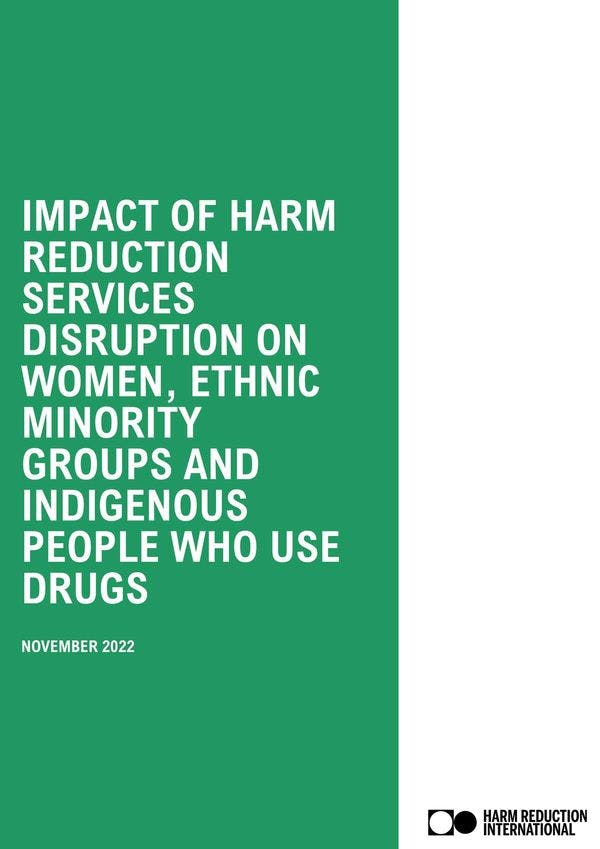Impact de l’interruption des services sur les femmes, les minorités ethniques et les peuples indigènes
HRI dresse l'inventaire d'une multitude d'obstacles à l'accès aux services de réduction des risques, notamment la stigmatisation, la violence sexiste et structurelle, la criminalisation, l'incarcération et le nombre limité de services tenant compte des spécificités du genre. Pour en savoir plus, en anglais, veuillez lire les informations ci-dessous.
Women, ethnic minority groups and Indigenous people who use drugs have been adversely affected by the spread of COVID-19. The introduction of swift executive orders and restrictions on movement by national governments may have contributed significantly to multiple challenges women have faced. In Indonesia, Kenya and South Africa, women experienced victimisation and violent treatment from family, intimate partners and law enforcement. Indigenous people suffered stigma from the community and, together with women who use drugs, experienced discrimination, harassment and exploitation by the police and healthcare workers. Other challenges affecting the health and rights of women, ethnic minority groups and Indigenous people who use drugs include limited access to quality health and social services, experiences of homelessness and the loss of social bonds and food security.
Availability and accessibility of harm reduction services for women, ethnic minority groups and Indigenous people are hindered notably by structural violence and stigma that result from patriarchal social norms and attitudes compounded by other identities such as poverty, class, race, ethnicity, and sexuality as well as a lack of harm reduction services attuned to their needs. This is apparent in the greater stigma faced by women who use drugs compared with men.
Many women, LGBTQI+ people and ethnic minority communities were isolated during the pandemic and did not access HIV and harm reduction services due to lockdown restrictions and transport difficulties. During lockdown, many outreach services were paused and activities that kept women connected were significantly halted. Worse still, paucity of harm reduction funding limited opportunities for service adaptations to meet the needs of women.
Generally, people who use drugs had minimal access to health services owing to healthcare worker shortages and limited contact with clients during the pandemic. This was particularly true for women, ethnic minority groups and Indigenous people as specific services for these demographics are limited and they are often not prioritised in harm reduction programming. Moreover, a lack of trust in healthcare workers and experiences of structural stigma and racism increased during COVID-19.These factors were compounded by changes in the drug supply, with the proliferation of toxic, illicit drugs together with limited access to drug checking, supervised consumption, in-person treatment and longer periods of isolation which have led to higher incidences of drug overdose and overdose-related deaths.
Nevertheless, the pandemic provided a window of opportunity for positive change as many services initiated rapid adaptations such as increased peer-led
outreach, provision of food, temporary shelters, personal protective equipment (PPE), information sharing and peer support. Community and civil society demonstrated strong leadership and a duty of care through advocacy which mitigated the negative outcomes for women, ethnic minority groups and Indigenous people.
Women, Ethnic Minority Groups and Indigenous people who use drugs faced multiple barriers to services
Women, ethnic minority groups and Indigenous people who use drugs are faced with many barriers to accessing harm reduction services such as stigma, gender-based and structural violence, criminalisation, incarceration and limited gender-responsive and gender-affirming services. The latest global systematic review of the epidemiology of people who inject drugs shows that there are approximately 2.8 million women who inject drugs globally,[19,20] and research indicates that more women than men are at greater infection risk from both HIV and viral hepatitis, with the highest burden seen in Africa, Eastern Europe, Latin America and Southeast Asia.
COVID-19 created conditions which increased existing barriers. Notably, lockdown expanded health, political and socioeconomic disparities. Women who use drugs are particularly vulnerable due to criminalisation and stigma.[24] A global survey by the International Network of People Who Use Drugs (INPUD) reported women who use drugs faced multiple challenges to health and support services with only 15% having access to women-specific programmes such as sexual and reproductive health services and childcare. Further studies indicate that emergency powers were disproportionately used by governments and law enforcement meting out violence towards Indigenous, Black and Brown people, women who use drugs, sex workers, people experiencing mental health issues, and trans people. Women and Indigenous people who use drugs endured violent treatment in particular from intimate partners and law enforcement mostly due to homelessness and the need to obtain drugs.
In the United Kingdom and the United States, Black and Brown people were not prioritised for care during the pandemic and were 8-10 times more at risk of being affected by COVID-19 than the white majority. The syndemic of COVID-19 and the opioid crises in these countries has also increased the harms experienced by women, ethnic minority groups and Indigenous people who use drugs, with limited access to pre-exposure prophylaxis (PrEP), naloxone, drug checking, supervised consumption, sterile syringes, methadone and psychosocial support, further demonstrating the effect of COVID-19 on expanding health disparities.
The impact on women, Indigenous people and migrants in the Middle East and North Africa has been disparate. In Aden (Yemen) for example, the government and civil society did not provide access to COVID-19 prevention and treatment for people who use drugs.
The crisis further exacerbated the vulnerabilities of Indigenous women and ethnic minorities, particularly those living in remote hard-to-reach locations, limiting access to harm reduction services. Low coverage heightened the difficulties in accessing safe and regular treatment. These factors reinforced the harms already faced, further driving many women underground. Furthermore, the global lockdown shifted the treatment landscape considerably. Low-threshold services, including services led by peers, reported staff absences due to illness and burnout, and increased homelessness and isolation among clients.
